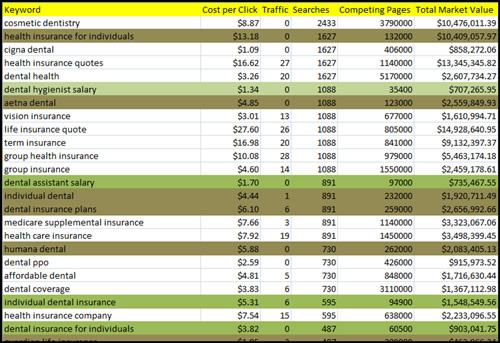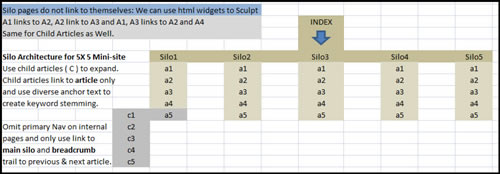Have you ever wondered how to SEO your website by mapping themed keywords into a silo site architecture?
Today’s post will provide a very simple method for determining where a keyword fits into the hierarchy of a website and how to integrate it into a theme to create a self-perpetuating ranking juggernaut in no time.
First of all, what is a theme? A Theme is a cluster of keywords targeted around a topical semantic base that reinforce each other (like rungs in a ladder).
Based on those rungs (also known as silos) as they can penetrate deep into other related semantic variations of the primary or secondary keyword; each page serves to provide ranking factor primarily to the apex (the theme) and other supporting rungs (pages or posts) with the anchor text they are aiding in ranking.
Where to Put Competitive Keywords
Logically, the more competitive the keyword (300K-1,000,000 competing pages or more), the more time, content and links you will have to dedicate to that keyword in order to gain traction.
Hence, those keywords should be emphasized though co-occurrence frequently within your website and what better way to accomplish this than weaving it into your primary site navigation structure.
We call this the tier 1 pages which reside flat in the site architecture in landing pages that are /in-the-root-folder not domain.com/category1/nested-folder2/landing-page.html
Once you have identified your tier 1 pages, you can reinforce them by integrating them with the most competitive keywords in the primary navigation.
As a result, you ensure that primary page garners link-flow as a touchstone for every indexed page (as it provides a link to your primary landing page).
Naming conventions are important and so is the anchor text selection “the text in the link”, therefore, you should keep both as succinct and “exact” as possible to ensure that the key ingredients are transferred and reinforced.
Where to Put Mid-Tail Keywords and Category Pages
While most mid tail keywords (keywords that are 100-300K competing pages in phrase match) that may not be the cat’s meow for your industry, they still have substantial search volume (en masse) and represent opportunities for conversions.
While this species of keyword is more common, getting them ranked still requires two critical components (1) links from above (from the tier 1 flat pages) to throw them a line using theme relevant pages that which are topically aligned and (2) links from below (to push link-flow up) from “child” a.k.a. supporting articles or posts (which are modeled after the parent mid-tail keyword) by incorporating some semantic shingle (phrase or group of words) into its title, link flow or content.
Building the Support System
The next part of the process is to identify how many supporting articles are needed, how many category pages (mid-tail keywords) are needed (to push up your primary tier 1 keywords) and how to selectively cross link them all using a coherent structure.
We use tools like DWS/Themezoom Revolution to accomplish this (as we collaborated and shared our most guarded ranking metrics as the engine for the keyword decisions screen for DWS).
There is more to this than meets the eye, such as template selection, link flow allocation and mapping out the number of inbound or outbound links leaving a page, however the primary function is to create a strong base of topical content (with supporting articles via a content management system) that you can drip content daily, a solid mid section of category / mid tail keywords (which you build links to) and a primary keyword / phrase at the top that gets ranked from inbound links and link flow moving up through the site architecture.
To simplify:
- Keywords under 100K competing pages are supporting articles (just place the keywords “in quotes” in a Google search to determine how competitive they are.
- Keywords 100-300K are mid-tail keywords (which need siloed pages to boost them up a bit) like rungs in a ladder.
- Keywords 300K or more are candidates for primary navigation (depending on your market).
While variables exist, the idea is to use the internal information architecture and flow of page rank and link flow to link to each page with the primary keyword THAT page is trying to rank for.
Do this enough (like a daisy chain) or what is considered “ring fencing” and the PR and ranking power naturally rises up in the site to become more buoyant and each page begins ranking the other pages “without backlinks from other sites”.
Observing the data below, for a market we mapped recently “Dental Insurance“, within minutes we were able to identify lucrative long tail (tier 3/ supporting articles – highlighted in light green) and mid-tail (tier 2/ category pages – highlighted in dark green) and Tier 1 keywords that were themes (highlighted in olive) which we would easily implement into a tiered site architecture and capture the entire vertical market.

long-tail articles (light green), mid tail (dark green), tier 1 theme pages (olive)
After you build a themed site using this methodology, then start the off page optimization and sprinkle in selective links from theme relevant sites gradually using a variety of anchor text and IP diversity.
Over time, this synergy provides enough internal link flow and enough off page citation and referential integrity to punch a hole in the SERPs and produces leaps and bounds for all of your collective keywords simultaneously (like the buddy system) .
In Closing
In case you haven’t noticed the lapse in posts on the SEO Design Solutions Blog, this will probably be one of the last for a while, as we are changing our business model and moving away from the service industry to focus on more internal projects.
The benefit to the SEO community is, we plan to share our new WordPress (WP Ultimate) shortly…to complement SEO Ultimate (in our opinion, one of the most powerful WordPress SEO Plugins out there), so, I hope you all enjoy the pearls shared in this post as we wind things down.
The tactics are scalable and we have used them to conquer every market from 200,000 competing pages to 200,000,000 competing pages without fail.
There is a great deal of Chicken little syndrome thinking that the sky is falling fear of Google algorithm changes as of late. The only thing you should take from this is “not to build flimsy sites”.
The only way to insulate yourself is to (1) focus on quality content and (2) know how to structure that content for users and search engines alike. The second part was laid out above, I leave the first part for you to manifest.
If you are seriously considering theming your website, then you will need a serious tool, such as Themezoom to drill into vertical online markets and discover missed keyword opportunities.
Enjoy!












Great stuff you give here in the article. I don’t know how much it will help me since I’m on Blogger. Other than concentrating on quality content and internal linking and backlinks. Hope to eventually move to a wordpress blog. Thanks.
Kev
@Kev:
As a blogger, at times, if you write about a specific topic, this type of structure will allow you to devour a series of keywords and capture a competitive keyword.
While everyone’s circumstances are unique, this is for businesses seeking to monetize their web presence or affiliates seeking to monetize traffic.
Thanks for visiting Kev.
Can you help my understand how and why looking at the number of “competing” pages in the index is a good indicator of TRUE competition? I always put more weight on the top 10 and their strength. In theory you could have 2 million indexed pages (with or without quotes) and if the top 10 has poor backlinking or isn’t specifically targeting that phrase, then why should I consider a highly competitive word?
In your experience how does the number of pages correlate with your ability to rank the word?
This is a great Article Thanks for Sharing with us.
Hi Jeffrey, thanks a lot for this article. I have been visiting your blog. I have some questions about this article that I would like to ask you about.
If I am exclusively trying to rank for a keyword that has characteristics of a supporting page (100,000 competing pages), should I build a silo around it, or will the on page SEO be enough to rank? Should I have other pages on the site just to have some other content on the website?
@Tikyda:
I would suggest a 10-15 supporting keyword silo with the perfect “exact match” landing page as the apex, then build approximately 8-15 links from PR2 or above pages to crack that one.
Thanks for visiting.
Hi Jeffrey,
Thanks a lot for responding. I just visited today and saw your response. This is really a blueprint. Thanks a lot!!
@Tikyda:
Sure thing, glad it made sense.
All the best!
Jeffrey…
This is a BEAUTIFUL post! I absolutely love your mind and I am glad that I found this blog! I found it from using the SEO Ultimate plugin you created which really is the Ultimate SEO plugin I’ve seen. I wanted to let you know that I retweeted this post and am now about to subscribe and download your free book but I had to stop by here first to say THANK YOU for such awesome information. You are a gift!
Sincerely,
~Julie Phineas~
Julie:
Thank you so much… Hope I have your consent to use that as a testimonial… wink/wink!
I will do that
thank you